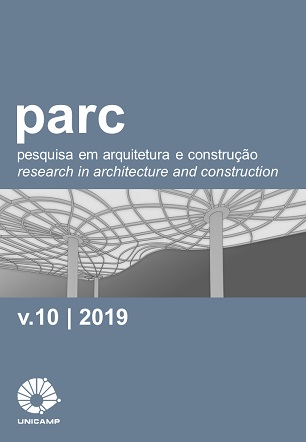Abstract
Considering the relevance of ‘as built’ for renovations and maintenance and the rising of new technologies in the 4.0 Industry, the contribution of 360-degrees photography in data survey and information validation stages for ‘as built’ modeling was analysed, comparing this technology to the traditional photography usually adopted. Based on empirical field surveys, two as built of the Fundação Nova Vida renovation process, in Florianópolis (SC), a public building dedicated to social assistance, were modeled in BIM software. With pre-renovation and post-renovation as built was possible to compare the two modalities: traditional photographs were taken in the pre-renovation stage, and 360-degrees spherical lens photographs were taken in the post-renovation stage. Parameters such as amount of contained information and size of generated photographic files were considered in the study. The 360-degrees photograph presented more available data and larger coverage area, which reduced the amount of files generated and the size of stored files. It was also verified that the traditional photograph, by not only involving the record itself, but also the decision-making about what to register, demands extra time in field surveying, while the 360-degrees photograph makes a global record. The 360-degrees photograph presented itself as a more effective tool if compared to the traditional photograph, allowing more agility in data verification to BIM modeling.
References
BARAZZETTI, Luigi; PREVITALI, Mattia; RONCORONI, Fabio. Can we use low-cost 360 degree cameras to create accurate 3D models? In: MID-TERM SYMPOSIUM OF THE INTERNATIONAL SOCIETY OF PHOTOGRAMMETRY, REMOTE SENSING AND SPACTIAL INFORMATION SCIENCE, 2., 2018, Riva del Garda. Annals […]. Riva del Garda: ISPRS, 2018, Vol. XLII-2. p. 69-75. DOI:https://doi.org/10.5194/isprs-archives-XLII-2-69-2018
BAUER, Wilhelm et al. Transforming to a hyper-connected society and economy – towards an “industry 4.0”. Procedia Manufacturing. Holanda, v. 3, p. 417 - 424. 2015. DOI: https://doi.org/10.1016/j.promfg.2015.07.200
BRASIL. Decreto n. 9.377, de 17 de maio de 2018. Institui a estratégia de disseminação do Building Information Modelling. Lex: Diário Oficial da União, Brasília, Edição 95, Seção 1, p. 3. ISSN 1677-7042.
CHAGAS JUNIOR, Edson das. Fotografia panorâmica multimídia: de Robert Barker ao fotógrafo panoramista - investigando a práxis do dispositivo. In: CONGRESSO DE CIÊNCIAS DA COMUNICAÇÃO NA REGIÃO SUDESTE, Vitória, 15., 2010, São Paulo. Anais [...]. São Paulo: Intercom, 2010.
COELHO, Pedro M. N. Rumo à indústria 4.0. 2016. 62 p. Dissertação (Mestrado em Engenharia e Gestão Industrial) – Departamento de Engenharia Mecânica, Faculdade de Ciências e Tecnologia, Universidade de Coimbra, Portugal, 2016.
EASTMAN, Charles M. et al. Manual de BIM – um guia de modelagem da informação da construção para arquitetos, engenheiros, gerentes, construtores e incorporadores. Tradução: Cervantes Gonçalves Alves Filho et al. Porto Alegre: Bookman, 2014.
KLEIN, Laura; LI, Nan; BECERIK-GERBER, Burcin. Imaged-based verification of as built documentation of operational buildings. Automation in Construction, Holanda, n. 21, p. 161 – 171, jan. 2012. DOI: https://doi.org/10.1016/j.autcon.2011.05.023
MENDONÇA, André N. F. et al. Fotografia panorâmica e sua relação homem-técnica. Informática na educação: teoria e prática, Porto Alegre, v.13, n.2, p. 102 – 111, jul./dez. 2010.
RAJKUMAR, Ragunathan et al. Cyber-physical systems: the next computing revolution. In: DESIGN AUTOMATION CONFERENCE, 47., 2010, Anaheim. Proceedings […]. Nova York: ACM, p. 731-736, 2010. DOI: https://doi.org/10.1145/1837274.1837461
RAMOS, Matheus M.; LAURENTIZ, Silvia. Crise sistêmica: um novo olhar sobre a fotografia. Discursos fotográficos. Londrina, v.9, n. 14, p. 55 - 70, 2013. DOI: http://dx.doi.org/10.5433/1984-7939.2013v9n14p55
SCHWAB, Klaus. The fourth industrial revolution. Suíça: World Economic Forum, 2016.
VICENTE, Carlos F. Fotografia: a questão eletrônica. In: SAMAIN, Etienne (org.). O fotográfico. São Paulo: Huitec/Senac, p.319-328. 2005.

This work is licensed under a Creative Commons Attribution 4.0 International License.
Copyright (c) 2019 PARC Research in Architecture and Building Construction


